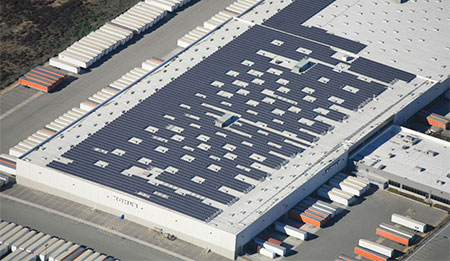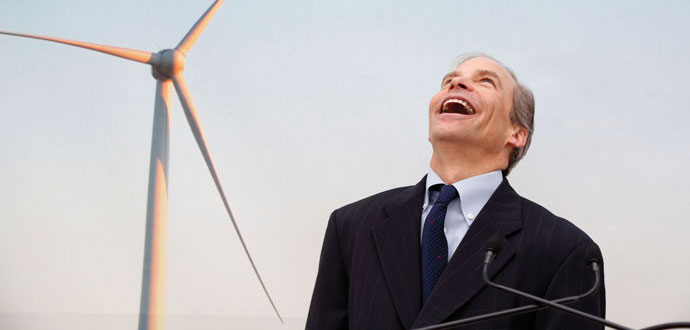Energy efficiency tweaks such as new HVAC systems and long-life light bulbs offer tremendous and quick gains, but they only get you so far. Sooner or later, as technology advances along with a company’s sustainability mandate, the search for that magic energy solution takes some corporate end users right to the power generation sources themselves.
How do on-site projects affect corporate real estate and facilities management? What are the byproducts, the cost savings and, perhaps, the models for replication at other sites?
Two companies based in Wisconsin have some ideas.
In February, SC Johnson, the manufacturer behind such brand-name products as Pledge, Glade and Windex, announced it had received a Climate Leadership Award from the EPA, the Association of Climate Change Officers, the Center for Climate and Energy Solutions and The Climate Registry for aggressive goal setting in reducing greenhouse gas (GHG) emissions.
“In addition to the 27-percent reduction we’ve achieved versus our 2005 U.S. baseline, we will continue to raise the bar and hold ourselves accountable,” said Fisk Johnson, chairman and CEO of SC Johnson. “By 2016, we plan to further reduce our greenhouse gas emissions by an additional 7-percent absolute reduction, and we’re honored to be recognized for setting this goal.”
Setting goals is one thing. Achieving them is another. But for SC Johnson, sustainability has been fundamental to operations for a long time. Clean energy initiatives from right next door and around the world demonstrate the company’s commitment to reducing its environmental footprint:
- The company recently added two wind turbines at its largest manufacturing facility, Waxdale, located in Mount Pleasant, Wis. The 415-foot wind turbines will produce about 8 million kilowatt hours (kWh) of electricity annually. Waxdale is now able to produce an average of 100 percent of its electrical energy on site. Waxdale, which is the size of 36 football fields, is home to additional clean energy initiatives. In the mid-2000s, two cogeneration systems were put in place that use waste methane gas from a nearby public landfill and natural gas to generate 85 percent of the facility’s electrical energy. Approximately 27 million KWH per year or 45 percent will be renewable energy from landfill gases used by co-generation unit one; on average, the remaining 23 million KWH or 40 percent will be from methane/clean energy used by co-generation unit two. The new wind turbines will provide the remaining 15 percent.

Kohl’s distribution facility in San Bernardino, Calif., features the company’s second-largest solar installation.
Photo courtesy of Kohl’s“This project shows that when wind energy and global manufacturing come together, it can have a phenomenal impact on improving our environment,” said Cathy Stepp, Secretary of the Wisconsin Department of Natural Resources, when the turbines were put into service in December. “Today is about celebrating the great leadership shown by SC Johnson, as well as encouraging other large companies to make similar efforts at finding greener ways to do business.” RENEW Wisconsin in January awarded the company its “Renewable Energy Customer-Generator of the Year” honor, specifically citing the company’s achievements in using renewable energy in its global manufacturing operations.
- The company has been purchasing wind energy from a dedicated nearby wind farm to help power its Bay City, Mich., facility since 2008. In 2011, the wind farm supplied 46 percent of the electricity required to run the facility.
- In 2010, SC Johnson began testing three SWIFT mini wind turbines at its global headquarters in Racine, Wis., famous for having been designed by Frank Lloyd Wright. In their first year of operations, the turbines cut GHG emissions by 580 pounds. In 2012, the company also added three of the mini turbines at its Lowell, Ark., sales office.
- In February, the company announced its participation in the Comision Federal de Electricidad’s (CFE/Federal Electricity Commission) wind farm program in Mexico. A power purchase agreement will enable SC Johnson to increase its use of renewable energy at its Toluca facility to an estimated 86 percent, up by 65 percent, and to decrease its greenhouse gas emissions for the same facility by 57 percent. The turbines are in Oaxaca and were constructed by ENEL, a multinational leader in power and gas, in partnership with the Comision Federal de Electricidad, who provides the infrastructure for energy transport. SC Johnson will begin using the purchased wind power mid-2013. Participation in the program, and the purchase agreement, demonstrate the company’s commitment to increasing its use of renewable energy to 44 percent of total electricity use worldwide by 2016.
- In Indonesia, the company uses waste palm shells as a fuel source to heat water for mosquito coil production at its manufacturing facility in Medan. By transferring a waste product back into the value chain, the company has cut GHG emissions at this facility by more than 15 percent. In Surabaya, a biofuel initiative launched in May 2012 uses waste husks from rice grains as a fuel source, rather than diesel fuel. This initiative is expected to generate 6 million kcal per hour to heat water used in mosquito coil production, and to reduce greenhouse gas emissions by 7,090 metric tons per year.
- In Shanghai China, several solar projects help provide hot water heating. One provides hot water for food service and other office needs. And solar-heated wastewater from the facility’s steam piping network aids aerosol production. The quality control lab uses solar-heated water as well.
- A 262-foot-tall wind turbine in the Netherlands helps power the SC Johnson European manufacturing facility.
‘Next Floor: Sun’
The other Wisconsin company leading the way in on-site power is Kohl’s, whose 3,000-job headquarters retention and expansion last year is among the Honorable Mention Top Deals of 2012 recognized elsewhere in this issue.
Winner of a Sustained Excellence award from the EPA’s 2013 Energy Start Partner of the Year program, Kohl’s has moved beyond hundreds of lighting retrofits and other energy efficiency improvements. The company has expanded its solar program by installing panels at 16 new locations in 2012 after doing so at 20 locations in 2011. It also activated its largest array of solar panels at its 1-million-sq.-ft. e-commerce distribution center in Edgewood, Md. To date, Kohl’s has more than 130 solar locations in 12 states, and is one of the largest single hosts of solar electricity production in North America. Kohl’s solar portfolio now totals nearly 42 MW, generating more than 57,400 Megawatt-hours (MWh) of electricity annually.
Kohl’s also purchased more than 1.5 billion kWh of green power in 2012, enough to offset more than 100 percent of the company’s purchased electricity use for the third consecutive year. The company ranks first in retail and second overall on EPA’s quarterly rankings of top green power purchasers.
The LEED-Gold Edgewood facility opened in 2011 and launched its solar plant in Dec. 2012. The 2.4-MW, 8,360-panel rooftop solar array will generate more than 3 million kWh of electricity annually and provide more than 40 percent of the facility’s energy. Until this project, Kohl’s largest solar site was its San Bernardino, Calif., distribution center with a 1-MW, 6,208-panel rooftop solar array. The Edgewood installation is the company’s sixth solar site in Maryland, and the facility itself is the company’s first LEED-certified logistics complex.
“The Edgewood facility demonstrates Kohl’s collective approach to environmental responsibility in many ways, including our commitment to collaboration with our partners and expanding our successful programs such as solar and LEED certification,” said John Worthington, Kohl’s chief administrative officer, in December. “We worked with experts internally and externally to maximize the sustainable aspects of this site, which ranged from expanding onto and retrofitting an existing building structure to addressing the nature of the distribution center as an industrial, round-the-clock facility with different operational considerations than what our stores may have. We are very pleased with the results and look forward to carrying forward what we have learned into future building and LEED projects.”
In April Kohl’s released its 2012 corporate social responsibility (CSR) report. Among the achievements as of the end of fiscal 2012, Kohl’s operated 137 solar arrays at stores and corporate facilities, including the 16 new locations added in 2012. Kohl’s aims to have 200 active solar arrays by 2015. It’s also set a goal as a member of the U.S. Department of Energy’s Better Buildings Challenge to reduce energy use by 20 percent in more than 112 million sq. ft. (10.4 million sq. m.) of occupied building space by 2020.
The company has 13 facilities in its distribution center portfolio, including other e-commerce fulfillment centers in Monroe, Ohio, and, as of last year, in DeSoto, Texas, where the company aims to create approximately 400 jobs over the next few years.
